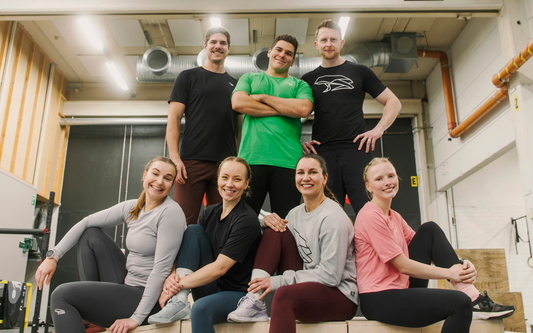We are a part of the textile industry; as the second-largest polluter in the world, it causes more emissions than aircraft and cargo ships put together. We are also part of the sportswear industry, an industry known for using oil-based fabrics that release microfibres during use and machine washing.
In our previous post we wrote about plastic in general, and now we want to talk more about it from the sportswear industry’s point of view.
Why are plastic-based fabrics used in sportswear?
In the midst of all this seemingly endless plastic and zero-waste discussion, one might ask why plastic is used in clothing in the first place.
We believe it is an important part of the design process to choose a material that is appropriate for the use of an item, and there are a couple of reasons why synthetic fabrics are still the best solution, at least for sportswear.
Many modern textiles include plastic. The most common synthetic materials are polyamide, polyester, elastane, polypropylene, and acryl. The availability of plastic materials have revolutionised the entire fashion industry. Also, the fast fashion industry was born with the rise in popularity of synthetic fabrics [1]. The past two decades have been the golden times for cheap, and cheap-looking, fast fashion items. Now the fashion industry is in the midst of change, and we at Népra work relentlessly to transform current buying habits and make slow fashion the norm, not the exception.
Synthetic materials like polyamide and polyester are diverse and easy to tailor, allowing us to achieve different types of sporty features. These materials are water repellent, light, and comfortable. [1] Synthetic fabrics are also more durable when it comes to abrasion, which is a very important factor for us as we create activewear for high-intensity sports like CrossFit and weightlifting. We want our items to last because it is the best thing we can do for the environment. Elastane is added to the materials to give the fabric flexibility - otherwise, your tights wouldn’t sit well at all.

After polyester, the most used material is cotton. Natural fabrics like cotton are perfect for everyday clothes. However, cotton absorbs moisture (and sweat) very easily, and therefore it gets very wet during sports. A sweaty t-shirt with pit stains might not feel good... at least that’s what we think! Also, it is almost impossible to increase global cotton production [3], and natural fibres are just not enough to fulfil the global need for fibres overall [1]. The growing of natural fibres is connected to intensive freshwater and chemical use, and it follows that agriculture is clearly linked to deteriorating biodiversity and soil degradation. The drying of the world’s fourth-largest lake, the Aral Sea, is tied to cotton production and the textile industry [2]. Moreover, farming and developing raw materials for the textile industry is known for its ethical problems.
Now that we have briefly recapped the problems associated with using natural fibres, let’s take a closer look at the problems of synthetic materials; plastic waste in the oceans and microplastics in general.
Plastic waste in the oceans
Globally, plastic production is 300 million tonnes annually. Between 6.4 and 8 million tonnes of plastic ends up in the oceans every year. This is equal to one truckload every single minute. [1] If this goes on, the oceans will contain more plastic than fish by 2050. [4]

If we want to attack the ocean plastic problem, we need to concentrate on the root cause- nonfunctional waste management in the target countries, rather than the well-known consequence- plastic waste in the ocean. [1]
Cleaning the oceans is the right thing to do, but as long as the amount of waste ending up in the oceans remains the same, it cannot be fixed once and for all. Countries that have the infrastructure and knowledge about proper waste management should help the countries with a waste problem [1]. Moreover, western countries are famous for dumbing down different kinds of waste in third countries. We are indeed part of the problem. The waste in the oceans is our waste as well. In the studies reporting about the origin of waste in Henderson Island a.k.a. Waste Island, found out that the rubbish was from all over the world including Europe and Northern America [1].
Sportswear & microplastic
Until now we have seen studies and articles writing about the microplastic results during machine washing and microfibres in oceans, lakes, and rivers. Before researching for this article, we hadn’t read about anything else either. However, a study from the University of Plymouth and National Research Council of Italy compared the microfibres released when washing clothes to the microplastics released when simply wearing them.
The scientists found out up to 4,000 fibres per gram of fabric can be released during a machine wash, while around 400 fibres per gram of fabric can be shed during just 20 minutes of normal activity [5]. The researchers estimate that annually per person, 300 million microfibres are released during the machine wash and up to 900 million microfibres are released when wearing clothes [6].

In the Helsingin Sanomat (HS) article, Ari Harlin, the research professor of VTT Technical Research Centre, says that the result is not surprising as the dust at our homes consists of dried skin and fibres from clothing. In the same HS article, Harlin notes that the best we can do to decrease the microplastic waste, for now, is to take good care of our clothing, avoid unnecessary wear and tear, and use items longer before washing them and before throwing them away. The better the quality of the fabric and the item, the longer the item’s lifespan. [6] Buy less, choose well, and make it last.
Generally, microplastics and plastics become a problem when they end up in nature [1]. There are an increasing number of technical solutions on how to minimise the microfibres caused by synthetic fabrics. There are microplastic washing bags, and if you need to buy a new wash machine, choose one with a microfibre filter [1]. According to a study made in the University of Jyväskylä, the water treatment plant in Jyväskylä is able to filter 99% of the microplastic in the wastewater [7]. This is great news!
All materials have their pros and cons, and no material can be seen more sustainable than the other when we consider the whole lifecycle from raw materials to recycling the used item. In the end, your personal preferences matter a lot, too. What type of clothing do you enjoy wearing time after time? Choose brands and items that share your core values. Buy items that fit the purpose and activity. From the environmental point of view, the best solution is always to buy less and use the items you have for longer.
Love,
Ama, Essi & Elsa
Edited by Alex Burchell

References:
-
Johanna Kohvakka, Liisa Lehtinen, 2019. Hyvä, paha muovi. Minerva.
-
The Guardian 01.10.2014: Cotton production linked to images of the dried up Aral Sea basin https://www.theguardian.com/sustainable-business/sustainable-fashion-blog/2014/oct/01/cotton-production-linked-to-images-of-the-dried-up-aral-sea-basin
-
World Economic Forum and Ellen MacArthur Foundation, The New Plastics Economy – Catalysing action (2017)
https://www.ellenmacarthurfoundation.org/assets/downloads/New-Plastics-Economy_Catalysing-Action_13-1-17.pdf -
Jyväskylän yliopisto 10.4.2019. Tutkimus: Nenäinniemen puhdistamo saa jätevedestä mikromuovin talteen tehokkaasti uudella kiekkosuodattimella.
-
University of Plymouth 10.3.2020: New study suggests wearing clothes could release more microfibres to the environment than washing them.
-
HS Tiede 13.03.2020: Mikromuovia irtoaa vaateissa käytössä enemmän kuin pesussa, ja kuitumäärät lasketaan miljoonissa.




